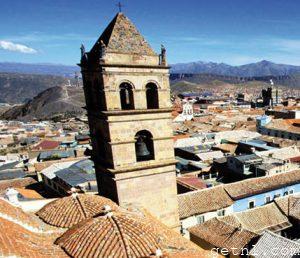
With its colonial grandeur and air of mystery, Potosí has the edge on better-known Cusco
NEED TO KNOW
There’s no shortage of people who have journeyed to Cusco in Peru and other cities along South America’s “gringo trail,” but very few have marveled at Potosí – a city that takes your breath away, and not only because of its high altitude. This majestic place is today home to the descendants of those who labored for the Spanish centuries ago, and has a colonial legacy to rival that of any other Latin American city.
Cusco, Lima, and Mexico City might all have their charms, but they also have plenty of drawbacks, not least their over-abundance of tourists. Much of Potosí is a peaceful treasure trove of colonial architecture, art, and antiques, where the past lingers on in grand old buildings and on charming cobbled streets.
The city’s proud motto – “I am rich Potosí, treasure of the world, king of the mountains, envy of kings” – coined by Charles I of Spain more than 400 years ago, only hints at Potosí’s former glory.
This was the world’s first boom town and the richest city in the New World for nearly two centuries, thanks to its fabled Cerro Rico – the world’s largest silver mine. Today, the mine’s once-prodigious output is everywhere to be seen. It adorns ceilings and walls in every other building, gleaming unexpectedly from dimly lit corners. The brilliant metal covers the altar in the Baroque Church of San Lorenzo, dominates the collection at the Casa de Moneda (Royal Mint) and can be seen in no less than nine museums and as many convents around the city.
More than 2,000 colonial buildings have been identified or preserved in Potosí, which is more than in any other Latin American city – it’s little wonder this remarkable place became Bolivia’s first UNESCO World Heritage Site in 1987.
MAIN CITY SIGHTS
Casa de Moneda Potosí’s first mint is now one of Latin America’s finest museums. It boasts an art gallery full of priceless viceregal paintings, a large exhibition space with displays on everything from colonial coins to current smelting techniques, and a larger-than-life mask of Bacchus in the courtyard that must be seen to be believed.
Convento y Museo de Santa Teresa This 1691 wonder, which is the center of all things Baroque in the city, does double duty as a museum and a convent – the nuns live next door. Here you’ll find some of the continent’s most impressive colonial and religious artworks, and exhibits on convent life.
Cerro Rico Words fail to describe this colossal monument to avarice, the silver mine, which has been a graveyard to more than a million miners over the centuries. A tour is an absolute must.
Churches of San Francisco, San Lorenzo, San Martín and the Jesuits These superb churches lie near each other in the heart of the city, and are widely considered to rank among the world’s finest examples of colonial architecture. They also house some outstanding pieces of religious art.
FORGET CUSCO?
GOING ANYWAY?
If Cusco is on your must-see list, opt for a trip to the city’s outlying areas, many of which have more to offer in terms of local culture. Here you’ll see more at your own pace, without the crowds and the pressure to buy yet another guided tour.
PRACTICAL INFORMATION
Getting There and Around
Getting to Potosí is no hardship.
The city is served by a high- altitude airport, which boasts fantastic views. Many travelers arrive via bus or 4WD from La Paz or Oruro, and enjoy equally impressive views on the way. The city is easy to walk around and taxis are plentiful and cheap.
Where to Eat
The cuisine in Potosí is similar to that found throughout the Andes, only it has more spice to it. There are myriad chicken- and potato-based dishes on offer, and warm soups are a traditional favorite. El Mesón, located on the main square, is an excellent restaurant and a great place to sample local dishes at affordable prices.
Where to Stay
Try the comfortable, centrally located Hostal Colonial. The friendly staff here have a well-deserved reputation for assisting travelers of all stripes.
When to Go
Potosí can be chilly all year round, but is most pleasant during the summer months, from June to August, when it is dry and sunny.
Budget per Day for Two
No more than US$75. Much of the city can be seen on foot, which brings travel costs down.
Prices here are among the lowest of anywhere on the continent.